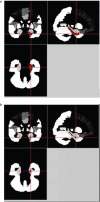Disrupted functional connectivity between perirhinal and parahippocampal cortices with hippocampal subfields in patients with mild cognitive impairment and Alzheimer's disease
- PMID: 29228757
- PMCID: PMC5716797
- DOI: 10.18632/oncotarget.17944
Disrupted functional connectivity between perirhinal and parahippocampal cortices with hippocampal subfields in patients with mild cognitive impairment and Alzheimer's disease
Abstract
Most patients with mild cognitive impairment and Alzheimer's disease can initially present memory loss. The medial temporal lobes are the brain regions most associated with declarative memory function. As sub-components of the MTL, the perirhinal cortex, parahippocampal cortex and hippocampus have also been identified as playing important roles in memory. The functional connectivity between hippocampus subfields and perirhnial cortices as well as parahippocampal cortices among normal cognition controls (NC group, n=33), mild cognitive impairment (MCI group, n=31) and Alzheimer's disease (AD group, n=27) was investigated in this study. The result shows significant differences of functional connectivity in 3 pairs of regions among NC group, MCI group and AD group: right perirhinal cortex with right hippocampus tail, left perirhinal cortex with right hippocampus tail, and right parahippocampal cortex with right hippocampus head. Clustering methods were used to classify NC group, MCI group and AD group (accuracy=100%) as well as different subtypes of mild cognitive impairment patients based on functional alterations. Functional connectivity disrupted between perirhinal and parahippocampal cortex with hippocampal subfields, which may provide a better understanding of the neurodegenerative progress of MCI and AD.
Keywords: AD; MCI; functional connectivity; parahippocampal cortex; perirhinal cortex.
Conflict of interest statement
CONFLICTS OF INTEREST I would like to declare on behalf of my co-authors that the work described was original research that has not been published previously, and not under consideration for publication elsewhere, in whole or in part. All the authors listed have approved the manuscript that is enclosed. I would also verify on behalf of my co-authors that NO organization may stand to gain financially now or in the future by the study. NO actual or potential conflicts of interest including any financial, personal or other relationships with other people or organizations within three years of beginning the work submitted that could inappropriately influence (bias) their work. All patients in our study provided written informed consent and the study was conducted according to the provisions of the Helsinki declaration.
Figures








Similar articles
-
Differential medial temporal lobe morphometric predictors of item- and relational-encoded memories in healthy individuals and in individuals with mild cognitive impairment and Alzheimer's disease.Alzheimers Dement (N Y). 2017 Mar 23;3(2):238-246. doi: 10.1016/j.trci.2017.03.002. eCollection 2017 Jun. Alzheimers Dement (N Y). 2017. PMID: 29067330 Free PMC article.
-
[Relationship between episodic memory and resting-state brain functional connectivity network in patients with Alzheimer's disease and mild cognition impairment].Zhonghua Yi Xue Za Zhi. 2013 Jun 18;93(23):1795-800. Zhonghua Yi Xue Za Zhi. 2013. PMID: 24124712 Chinese.
-
Encoding of novel picture pairs activates the perirhinal cortex: an fMRI study.Hippocampus. 2003;13(1):67-80. doi: 10.1002/hipo.10049. Hippocampus. 2003. PMID: 12625459
-
Functional neuroanatomy of the parahippocampal region in the rat: the perirhinal and postrhinal cortices.Hippocampus. 2007;17(9):709-22. doi: 10.1002/hipo.20314. Hippocampus. 2007. PMID: 17604355 Review.
-
Detecting Early Cognitive Decline in Alzheimer's Disease with Brain Synaptic Structural and Functional Evaluation.Biomedicines. 2023 Jan 26;11(2):355. doi: 10.3390/biomedicines11020355. Biomedicines. 2023. PMID: 36830892 Free PMC article. Review.
Cited by
-
Crosstalk between Depression and Dementia with Resting-State fMRI Studies and Its Relationship with Cognitive Functioning.Biomedicines. 2021 Jan 16;9(1):82. doi: 10.3390/biomedicines9010082. Biomedicines. 2021. PMID: 33467174 Free PMC article. Review.
-
Altered Directed Functional Connectivity of the Hippocampus in Mild Cognitive Impairment and Alzheimer's Disease: A Resting-State fMRI Study.Front Aging Neurosci. 2019 Dec 3;11:326. doi: 10.3389/fnagi.2019.00326. eCollection 2019. Front Aging Neurosci. 2019. PMID: 31866850 Free PMC article.
-
Polygenic hazard score modified the relationship between hippocampal subfield atrophy and episodic memory in older adults.Front Aging Neurosci. 2022 Oct 31;14:943702. doi: 10.3389/fnagi.2022.943702. eCollection 2022. Front Aging Neurosci. 2022. PMID: 36389062 Free PMC article.
-
A fusion analytic framework for investigating functional brain connectivity differences using resting-state fMRI.Front Neurosci. 2024 Dec 11;18:1402657. doi: 10.3389/fnins.2024.1402657. eCollection 2024. Front Neurosci. 2024. PMID: 39723421 Free PMC article.
References
-
- Burns A, Iliffe S, Maurer K. Alzheimer's disease. BMJ. 2009;338:b158. - PubMed
-
- Grundman M, Petersen RC, Ferris SH, Thomas RG, Aisen PS, Bennett DA, Foster NL, Jack CR, Jr, Galasko DR, Doody R, Kaye J, Sano M, Mohs R, et al. Alzheimer's Disease Cooperative Study Mild cognitive impairment can be distinguished from Alzheimer disease and normal aging for clinical trials. Arch Neurol. 2004;61:59–66. - PubMed
-
- Winblad B, Palmer K, Kivipelto M, Jelic V, Fratiglioni L, Wahlund LO, Nordberg A, Bäckman L, Albert M, Almkvist O, Arai H, Basun H, Blennow K, et al. Mild cognitive impairment—beyond controversies, towards a consensus: report of the International Working Group on Mild Cognitive Impairment. J Intern Med. 2004;256:240–46. - PubMed
-
- Petersen RC, Doody R, Kurz A, Mohs RC, Morris JC, Rabins PV, Ritchie K, Rossor M, Thal L, Winblad B. Current concepts in mild cognitive impairment. Arch Neurol. 2001;58:1985–92. - PubMed
LinkOut - more resources
Full Text Sources
Other Literature Sources
Research Materials

